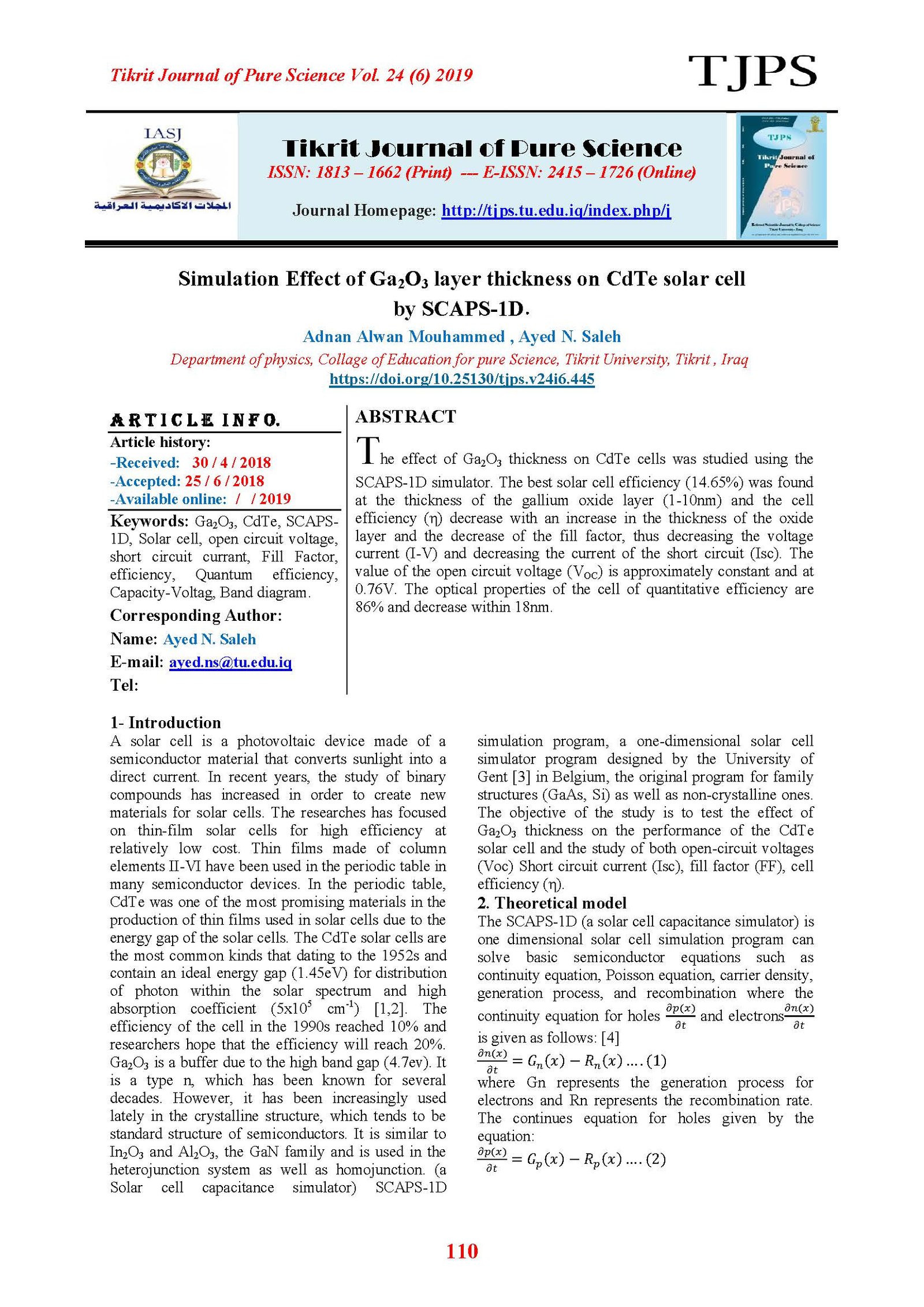Simulation Effect of Ga2O3 layer thickness on CdTe solar cell by SCAPS-1D.
Main Article Content
Abstract
The effect of Ga2O3 thickness on CdTe cells was studied using the SCAPS-1D simulator. The best solar cell efficiency (14.65%) was found at the thickness of the gallium oxide layer (1-10nm) and the cell efficiency (η) decrease with an increase in the thickness of the oxide layer and the decrease of the fill factor, thus decreasing the voltage current (I-V) and decreasing the current of the short circuit (Isc). The value of the open circuit voltage (VOC) is approximately constant and at 0.76V. The optical properties of the cell of quantitative efficiency are 86% and decrease within 18nm.
Article Details

This work is licensed under a Creative Commons Attribution 4.0 International License.
Tikrit Journal of Pure Science is licensed under the Creative Commons Attribution 4.0 International License, which allows users to copy, create extracts, abstracts, and new works from the article, alter and revise the article, and make commercial use of the article (including reuse and/or resale of the article by commercial entities), provided the user gives appropriate credit (with a link to the formal publication through the relevant DOI), provides a link to the license, indicates if changes were made, and the licensor is not represented as endorsing the use made of the work. The authors hold the copyright for their published work on the Tikrit J. Pure Sci. website, while Tikrit J. Pure Sci. is responsible for appreciate citation of their work, which is released under CC-BY-4.0, enabling the unrestricted use, distribution, and reproduction of an article in any medium, provided that the original work is properly cited.
References
[1] Cusano D. A. (1963). CdTe Solar Cells and PV Heterojunctions in II-VI Compounds. Solid State Electronics,6 (3):217–218
[2] Farhana Anwar (2017). Simulation and Performance Study of Nanowire CdS/CdTe Solar Cell. International Journal of Renewable Energy Research,7(2):885-893
[3] M. Burgelman, P. Nollet, S. Degrave (2000). Modelling polycrystalline semiconductor solar cells. Thin Solid Films, 361(362):527-532
[4] Roland Scheer and Hans-Werner Schock (2011). Chalcogenide Photovoltaics. Physics, Technologies and Thin Film Devices
[5] Usha Mandadapu, S. Victor Vedanayakam and K. Thyagarajan (2017).Simulation and Analysis of Lead based Perovskite Solar Cell using SCAPS. Indian Journal of Science and Technology, 10(11):17485-110721
[6] M. Higashiwaki, K. Sasaki, A. Kuramata, T. Masui, and S. Yamakoshi, (2016). Recent progress in Ga2O3 power devices. Appl. Phys,31(3):0268-1242
[7] Ganvir, Rasika, (2016). Modeling of the nanowire Cds-Cdte device design for enhanced quantum efficiency in window-absorber type solar cell. Ph.D. Thesis, Electrical and Computer Engineering. University of Kentucky [8] Ting Wang, Shokouh S, Farvid, Mutalifu Abulikemu and Pavle V. Radovanovic (2010).Size-Tunable Phosphorescence in Colloidal Metastable γ-Ga2O3 Nanocrystals. J. Am. Chem. Soc, 132(27): 9250–9252
[9] A.s Grove (1967). physics and technology of semi-conductor Device "john willay
[10] Song chen, E. small, Chan M. Amt (2012). Inverted polymer solar cell with reduced interface recombination .,1(11):1333-1337
[11] Sites, J. (2003). Quantification of losses in thin film polycrystalline solar cell" Solar Energy Materials and Solar Cells,75(2):243-251
[12] Mohammed H. Oushmand, M. Hossein Zandi and Nima E. Gorji (2015). SCAPS Modeling for Degradation of Ultrathin CdTe Films: Materials Inter diffusion, The Minerals, Metals & Materials Society, JOM,67(9): 2062-2070
[13] Wolf gang trees, karl leo and Moritz riede (2012). optimum mobility contact properties and open circuit voltage of organic solar cell Adrift diffusion study. physics review ,85(15):155119
[14] Roy Gordon, Hu Jianhua (1992). Electrical and Optical properties of doped tin and zinc oxide thin films by atmospheric pressure chemical vapor deposition. AIP Conference proceedings, 268(1):152-156
[15] P.S. Mondal, K. P. Kanta and P. Mitra (2008). Preparation of Al-doped ZnO (AZO) Thin Film by solar. Journal of Physical Sciences,12(24),:221-229
[16] Meydin ye, Jiaojio Gang, Yuken Lai, Changjin lin, and Zhigun Lin (2012). High-Efficiency Photo electro catalytic Hydrogen Generation Enabled by Palladium Quantum Dots-Sensitized TiO2 Nanotube Arrays.,134(38):15720-15723
